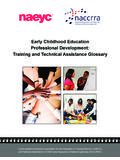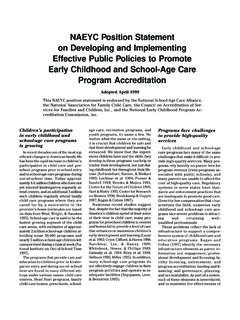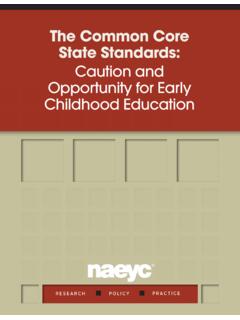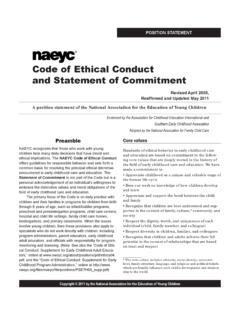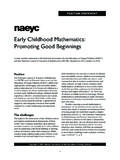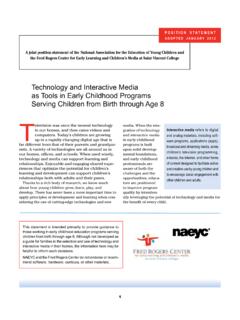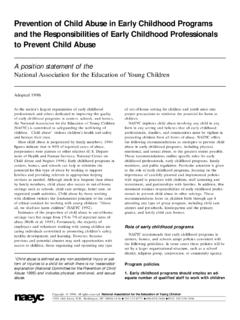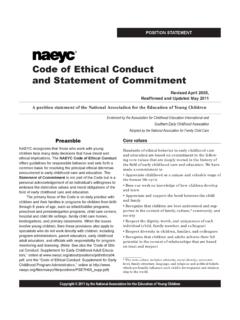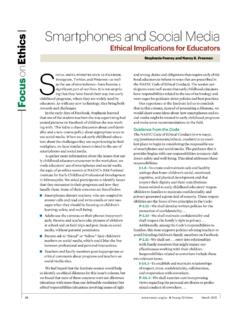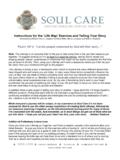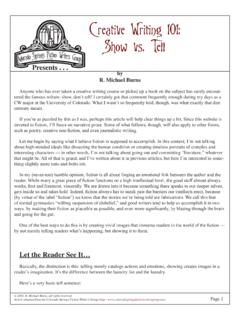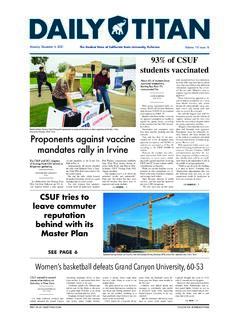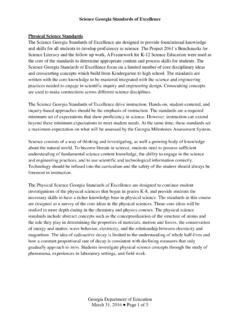Transcription of Learning Language and Literacy - NAEYC
1 N Young Children March 2002 Rebecca T. Isbell, , is director of the Center of Excellence in Early Childhood Learning and Development and professor of early childhood education at East Tennessee State University in Johnson City. She has studied and researched storytelling for over 20 years. She and Shirley Raines have collected stories that are appropriate to tell young children in Tell It Again and Tell It Again 2 (both from Gryphon House). oung children are active participants in build-ing Language and Literacy skills. They learn as they participate in meaningful experiences and interact with children and adults, construct-ing Language during the process. Much of the Language children learn reflects the Language and behavior of the adult models they interact with and listen to (Strickland & Morrow 1989).
2 Adults scaffold children s Language Learning by providing a model that is expressive, responsive, and enjoyable. One way to enrich children s Language experience is through the use of storytelling. Many studies have shown that children build vocabulary, use more com-plex sentences, and improve comprehension when frequently exposed to stories. Egan (1986) explains that we remember best in story form; he supports the use of stories as a way of organizing curriculum for children. The magnetic quality of the story is the universal power to remember, entertain, teach, inspire, create, and know (Raines & Isbell 1994).Comparing reading aloud and telling stories Reading aloud and telling stories are both effective ways to share literature with young children and to sup-port Language and Literacy Learning .
3 But while story read-ing frequently occurs in early childhood settings and is valued as an important tool to enhance Literacy develop-ment, storytelling is frequently viewed as a frill and only occasionally used in classrooms (Cooter 1991). Mallan (1996) explains that the story and storytelling are es-sential to human existence. The story told has distinc-tive characteristics that make it an excellent technique to foster oral Language development and provide a rich foundation for Literacy . The experience of hearing a story told is more per-sonal and connected to the listener. The storyteller can maintain eye contact and adapt the telling of the story to specific listeners; a story reader usually follows the text exactly and focuses her eyes on the words on the page.
4 The Language of storytelling is often more infor-mal than printed text. Listeners, regardless of their Language skills or reading abilities, can understand the story because it is communicated through words, vo-cal intonation, gestures, facial expressions, and body movement (Mallan 1997). For these reasons, storytell-ing connects to the Language of the children and there-by has the potential for increasing their understanding of the story. Storytelling promotes expressive Language develop-ment in oral and written forms and presents new vocabulary and complex Language in a powerful form that inspires children to emulate the model they have experienced. Stauffer (1980) says that the function of Language is to communicate, and communication is the main purpose of Language .
5 In the personal setting of the storytelling environment, the storyteller s Language and the story together establish a rapport that encour- telling and Retelling StoriesLearning Language and LiteracyY Elizabeth WolfRebecca T. Isbell Supporting Language learningYoung Children March 2002 n 27ages children to connect to the story using their own Language and experiences. The storytelling experience assists children in generating stories and encourages their dictation and story writing (Nelson 1989).Teacher as teller of stories Early childhood teachers who use storytelling effec-tively tell stories in their own words and adjust the tale to reflect the characteristics of their audience.
6 They use expression, gestures, and animation to draw the chil-dren to the story and the event. The teacher who selects and tells a wonderful story to young children provides a powerful oral Language model to imitate. She plays a critical role in influencing children s attitudes toward oral Language , reading, and literature (Morrow 2001). Appropriate and tantalizing tales can be told again and again. Stories that make a personal connection to the children are requested and enjoyed many times, over a long period of listening and participation The teacher as story-teller can help children develop critical and active listening skills. Because children acquire Language through active participa-tion, teachers should encourage involvement during the telling of the story.
7 Many stories that work well with young children include repetitive phrases, unique words, and enticing descriptions. An example is in the telling of How the Camel Got His Hump, an adaptation by Isbell and Raines (2000) of the classic story by Rud-yard Kipling. Each time the camel is asked to work, he responds, Humph! He uses this interest-ing word again and again. After the second request to the camel, children frequently join in the camel s response, Humph! Some stories include sound effects or repeated phrases that children can play with or repeat during the telling . Listening to stories draws attention to the sounds of Language and helps children develop a sensitivity to the way Language works.
8 Children, as listeners and participants, experience the joy of the repetitive phrase millions and billions and trillions of cats or the musical quality of the chant fee-fi-fo-fum. Developing auditory discrimination connects the sounds of words, phrases, and passages, influencing phonemic awareness in a meaningful way. When children begin to read a familiar story, these sound phrases are often the first words of the story they identify and repeat. Drawing children into the telling helps them under-stand how the story works, what phrases are repeated, and the sequence of action. Active participation in Literacy experiences can enhance the development of comprehension, oral Language , and the sense of story structure (Morrow 1985).
9 Storytelling events that ac-tively engage listeners in the making of the story create a shared experience that bonds the teller and listeners. Active listeners play an integral part in the storytell-ing process. By providing immediate feedback to the storyteller and sharing their observations, the children create the experience together. This personal interac-tion and active participation is very different from the story viewing that young children frequently experience in today s high-tech world (Hamilton & Weiss 1990). Stories presented in a visual form through television, videos, or movies cannot personally involve children or invite them into the story. Active listening and co-creating with the teacher serve as catalysts for generating ideas at the intersection of the story told and chil-dren s own experiences.
10 Follow-up discussions provide opportunities for children to express their ideas and experiences and to listen to what others have to say. Problem solving takes place in the context of the story: Why did the little red hen not share her bread? or How did the Bremen musicians scare the thieves? Children from different backgrounds and diverse cultures can share their interpretations of the story and relate them to their own experiences. They retell and recreate the learn through retelling The first telling of a story by the teacher to a group of young children is an exciting introduction to the con-tent, while retelling of the same story allows children to revisit the tale and refine their understanding.
